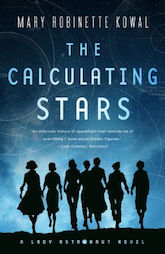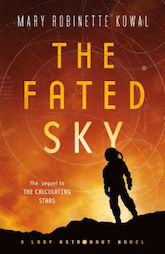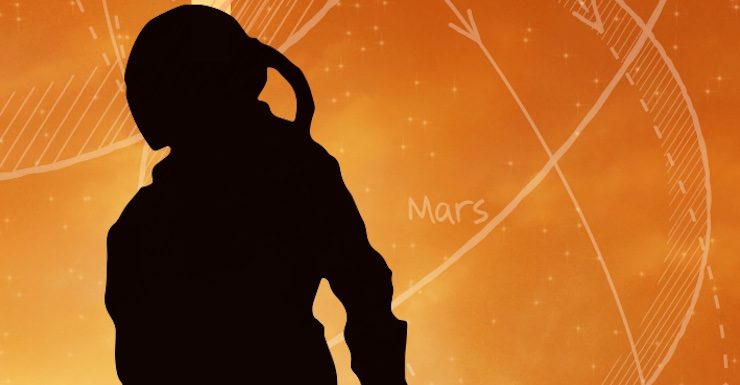Picture this: It’s the 1960s. Earth was flattened by a meteor, and humanity’s time is ticking as temperatures rise and catastrophic climate change looms like a spectre. A young, world-famous astronaut, pilot, and mathematician bounds through the tunnels of Bradbury, a human-populated moonbase with Mars on her mind. It’s a gorgeous, electrifying concept executed flawlessly by Mary Robinette Kowal.
The Fated Sky is the second volume in a prequel duology to Kowal’s Hugo Award-winning novelette, “The Lady Astronaut of Mars.” The first volume, The Calculating Stars, which I enjoyed tremendously, introduced readers to a young Elma York, who readers met in the novelette as the titular “Lady Astronaut of Mars,” and tells the story of her involvement in humanity’s reach for the stars after a catastrophic meteor strike wipes out most of the United State’s eastern seaboard. One of the reasons “The Lady Astronaut of Mars” was notable was due to its fascinating alternate history which saw humanity colonize Mars in the mid-late 20th century. How they got there remained a bit of a mystery in the novelette, but the whole process is revealed, in calculated, well-researched and thrilling detail, in The Calculating Stars and The Fated Sky.
The Calculating Stars followed Elma and humanity’s efforts to land a person on the moon, their first step toward the stars, and most of the action took place on Earth. The Fated Sky is a much different novel—several years have passed since the end of The Calculating Stars and humanity is firmly entrenched on the moon. Elma has completed the trip between the Earth and moon a dozen times, to the point that what was once groundbreaking has become routine and boring. The scope of The Fated Sky remains gargantuan, as humanity sets its sights on Mars, but the confines are miniscule: most of The Fated Sky takes place aboard one of the two manned-ships headed toward the red planet.
Buy the Book


The Calculating Stars
As with much of Kowal’s work, there’s a warm empathy underlying everything in The Fated Sky. Elma makes mistakes, she hurts people, she’s selfish at times, but when she looks in the mirror and recognizes these flaws she aims, always, to soothe or undo the harm she has caused. The Lady Astronaut series starts with an earth-shattering meteor strike, an event which often precludes a devastating, harrowing portrait of humanity clinging to existence, but The Fated Sky hews towards hopefulness and wonder. By its conclusion, you can’t help but share Elma’s optimism. In a sense, considering the series’ beginnings as a novella set decades after the novels, in which we’re privy to humanity’s escape from Earth, it’s shrewd of Kowal to recognize that the series’ true conflict is not “Will humanity survive?” but, “How will humanity survive?”
To the end, The Lady Astronaut series has always been about Elma’s relationship with those around her—sure, it’s couched in a doomsday narrative, but that’s just window dressing for the conflict that arises between Elma and the others on the mission to correct humanity’s course. They’re Elma’s allies, working toward the same end, but they’re also individuals with their own goals, agendas, and worldviews. With the exception of a truly despicable South African, it’s a pleasure to get to know Elma’s fellow crew members—even when they’re at odds with her. Kowal beautifully captures the camaraderie and conflict borne of seven people from different walks of life in a small ship for years.
The personal and professional tension between Elma and Florence, one of the mission’s two African American astronauts, is complex and illustrates Kowal’s intense and impressive efforts to explore race and gender politics on a broad and personal scale. The novel’s crowning achievement, however, is the culmination of the years-long rivalry between Elma and Stetson Parker. Parker is no less vile, no less a misogynistic pig, than he was in The Calculating Stars—but the close confines and shared challenges between Elma and Parker force the dynamics of their relationship into the spotlight. Kowal does a remarkable job of adding layers of complexity to Parker that elevate him beyond being a petty villain. I’ve come to expect a certain level of emotional nuance in Kowal’s books, but even so her handling of Parker caught me off guard in the best way.
There’s another relationship in The Fated Sky that deserves to be touched upon, for entirely different reasons: Elma and her husband Nathaniel. In a series that delves so heavily into interpersonal conflict, Elma’s warm, loving, and respectful marriage with Nathaniel becomes an important reminder of why she’s fighting so hard to provide humanity with a future. Many times, authors become so invested in building up believable conflict that they neglect to give readers a reason to care. The goodness that exists between Elma and Nathaniel does exactly this. Every mile that separates Elma from Nathaniel is keenly felt by the reader. And then, of course, it provides an immense weight to Elma’s Choice in “The Lady Astronaut of Mars.” Every touch, every moment they share together becomes bittersweet.
Once again, Kowal’s intense dedication to research and scientific realism pays off. Where The Calculating Stars was focused on the meteor strike and its resulting climate change, The Fated Sky delves deep into the complexities of long-term space travel. I’m a sucker for a good bottle episode and generation ship story both, and The Fated Sky delivers wonderfully in both regards. We get to see the aforementioned tension between astronauts, but also a good, long look at the engineering, physics, and chemistry required to get humans to Mars. Kowal never skimps on the details, and every problem that arises (even floating, spherical urine) feels well thought out and realistic.
Buy the Book


The Fated Sky
When Kowal announced a pair of prequel novels to “The Lady Astronaut of Mars,” I was excited—but a part of me was unsure whether it was a story that needed expanding. Not because the alternate history wasn’t worth exploring, but be cause Elma’s narrative within the novelette was nearly perfect. The Calculated Stars and The Fated Sky delivered above and beyond my high expectations. In many ways enriched and surpassed their source material. By taking the emotional nuance of the original novelette and combining it with well-research worldbuilding and a riveting plot, Kowal has created a series ripe with potential.
What began in The Calculating Stars concludes beautifully in The Fated Sky—full of wonder and a promise of a brighter future. Whenever Kowal takes on a new genre, she brings her trademark wit, intelligence, and humour with her, and science fiction readers who have yet to discover her are in a for a treat. The Fated Sky is a tense, smart, and nuanced tale about perseverance, hope, and kindness. As much as I loved The Calculating Stars, The Fated Sky is even better.
The Fated Sky is available from Tor Books.
Aidan Moher is the Hugo Award-winning founder of A Dribble of Ink, author of “Youngblood,” “On the Phone with Goblins,” and “The Penelope Qingdom,” and a regular contributor to Tor.com and the Barnes & Noble SF&F Blog. Aidan lives on Vancouver Island with his wife and daughter, but you can most easily find him on Twitter @adribbleofink and Patreon.











So which order should I read these in? By release date or in chronological order?
@sdzald–That’s a good question. I was happy to read them in publication order, despite the way the original novelette “spoils” the novels. There’s enough new content in the novels that’s only vaguely hinted at in the novelette that it feel fresh, tense, and exciting.
That said, there’s nothing wrong with reading the novels first, then the novelette.